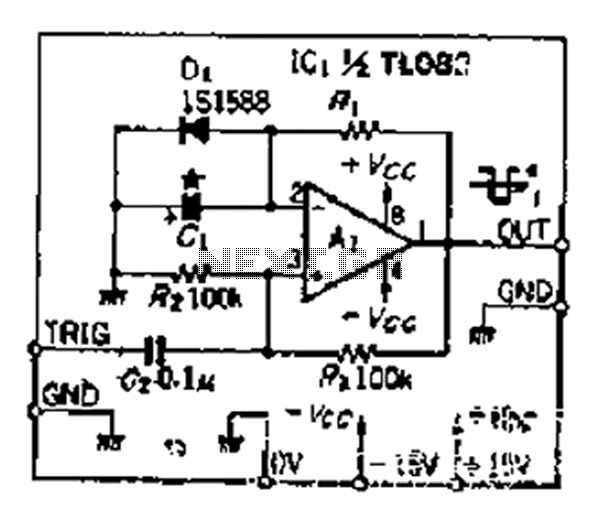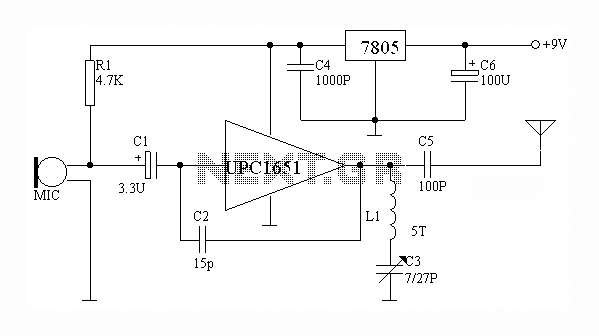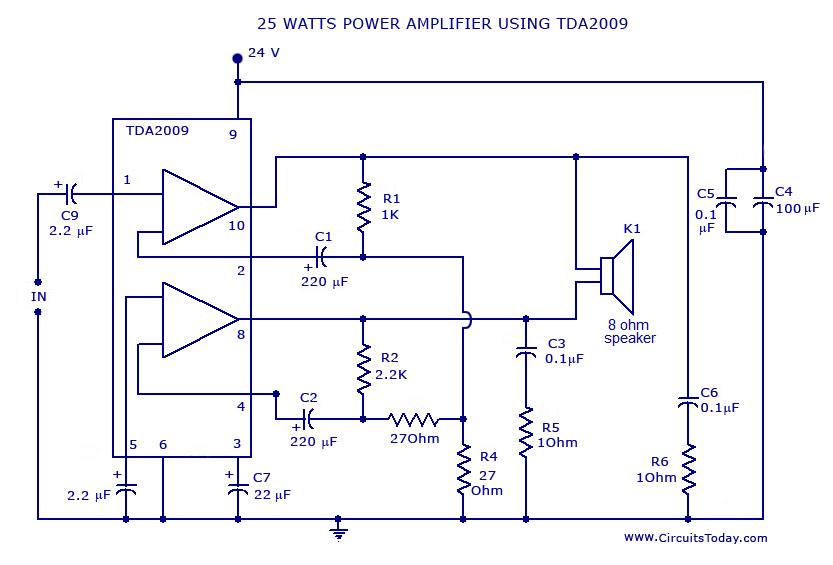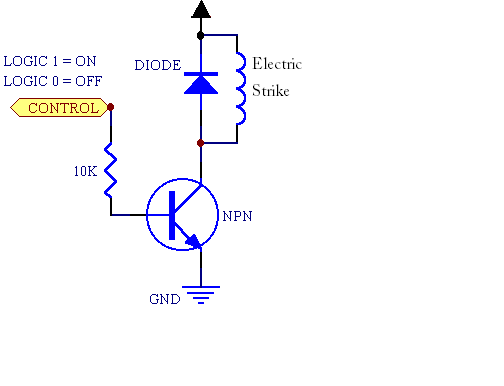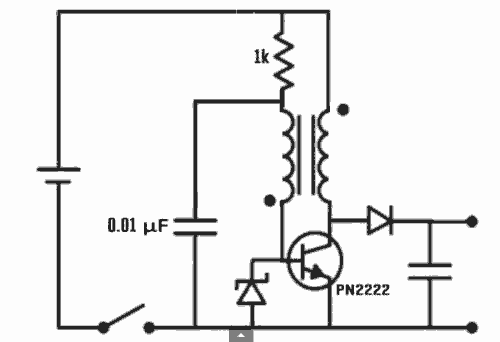
Cordless telephone voice processing circuit diagram
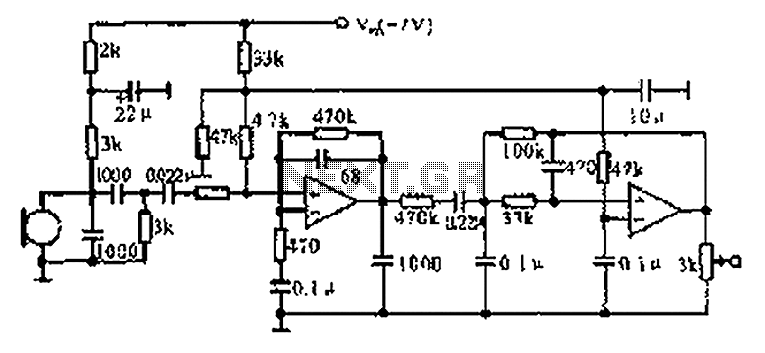
The CX9800 models of mobile phones and desktop PCs feature a high-performance voice processing circuit that compresses the amplitude and bandwidth of the microphone signal. This design enhances the sensitivity of the microphone and its adaptability to varying distances. It includes a first-level limiting amplifier followed by a second-stage active filter. A high-pass RC filter is inserted between the microphone and the amplifier, which pre-emphasizes the input signal. The receiving de-emphasis circuit at the output of the frequency discriminator improves the signal-to-noise ratio of the voice signal. The phone amplifier uses the 4558 model, while the Taiwan version employs two single op-amp circuits, model 741.
The CX9800 series integrates advanced voice processing capabilities that are essential for optimizing audio performance in mobile and desktop applications. The circuit's design begins with the microphone, where the initial signal is captured. The amplitude and bandwidth compression is crucial for enhancing the microphone's sensitivity, allowing it to perform effectively over various distances.
The first-level limiting amplifier plays a vital role in controlling the dynamic range of the audio signal, ensuring that it remains within a manageable level to prevent distortion. Following this, the second-stage active filter refines the signal further, eliminating unwanted frequencies and enhancing the clarity of the audio output.
Incorporating a high-pass RC filter between the microphone and the amplifier is a strategic choice. This filter effectively removes low-frequency noise, which is particularly beneficial in environments where background sounds could interfere with voice clarity. The pre-emphasis applied at the amplifier input boosts certain frequency components of the signal, preparing it for optimal processing.
The de-emphasis circuit at the output of the frequency discriminator is designed to counteract the effects of the pre-emphasis, ensuring that the final output maintains a balanced frequency response. This circuit is critical for improving the signal-to-noise ratio, which directly influences the intelligibility and quality of voice communications.
The choice of the 4558 op-amp for the phone amplifier highlights the design's focus on reliability and performance. This dual op-amp configuration allows for efficient signal processing, while the use of the 741 single op-amps in the Taiwan variant provides flexibility in circuit design and implementation.
Overall, the CX9800 voice processing circuit exemplifies a well-engineered approach to audio signal management, utilizing various filtering and amplification techniques to deliver high-quality voice performance in mobile and desktop environments. CX9800 models of mobile phones and desktop PC have chosen excellent performance voice processing circuit, the amplitude and bandwidth of the microphone signal is compressed to improve the sensitivity of the microphone and microphone distance adaptability. The first level limiting amplifier, the second stage of active filter. Inserted between the microphone and the amplifier a high-pass RC filter, the amplifier input signal pre-emphasis; receiving de-emphasis circuit in the frequency discriminator output circuit can be improved signal to noise ratio of the voice signal. Phone amplifier selection 4558, Taiwan machine selects two single op-amp circuit, model 741.
The CX9800 series integrates advanced voice processing capabilities that are essential for optimizing audio performance in mobile and desktop applications. The circuit's design begins with the microphone, where the initial signal is captured. The amplitude and bandwidth compression is crucial for enhancing the microphone's sensitivity, allowing it to perform effectively over various distances.
The first-level limiting amplifier plays a vital role in controlling the dynamic range of the audio signal, ensuring that it remains within a manageable level to prevent distortion. Following this, the second-stage active filter refines the signal further, eliminating unwanted frequencies and enhancing the clarity of the audio output.
Incorporating a high-pass RC filter between the microphone and the amplifier is a strategic choice. This filter effectively removes low-frequency noise, which is particularly beneficial in environments where background sounds could interfere with voice clarity. The pre-emphasis applied at the amplifier input boosts certain frequency components of the signal, preparing it for optimal processing.
The de-emphasis circuit at the output of the frequency discriminator is designed to counteract the effects of the pre-emphasis, ensuring that the final output maintains a balanced frequency response. This circuit is critical for improving the signal-to-noise ratio, which directly influences the intelligibility and quality of voice communications.
The choice of the 4558 op-amp for the phone amplifier highlights the design's focus on reliability and performance. This dual op-amp configuration allows for efficient signal processing, while the use of the 741 single op-amps in the Taiwan variant provides flexibility in circuit design and implementation.
Overall, the CX9800 voice processing circuit exemplifies a well-engineered approach to audio signal management, utilizing various filtering and amplification techniques to deliver high-quality voice performance in mobile and desktop environments. CX9800 models of mobile phones and desktop PC have chosen excellent performance voice processing circuit, the amplitude and bandwidth of the microphone signal is compressed to improve the sensitivity of the microphone and microphone distance adaptability. The first level limiting amplifier, the second stage of active filter. Inserted between the microphone and the amplifier a high-pass RC filter, the amplifier input signal pre-emphasis; receiving de-emphasis circuit in the frequency discriminator output circuit can be improved signal to noise ratio of the voice signal. Phone amplifier selection 4558, Taiwan machine selects two single op-amp circuit, model 741.
